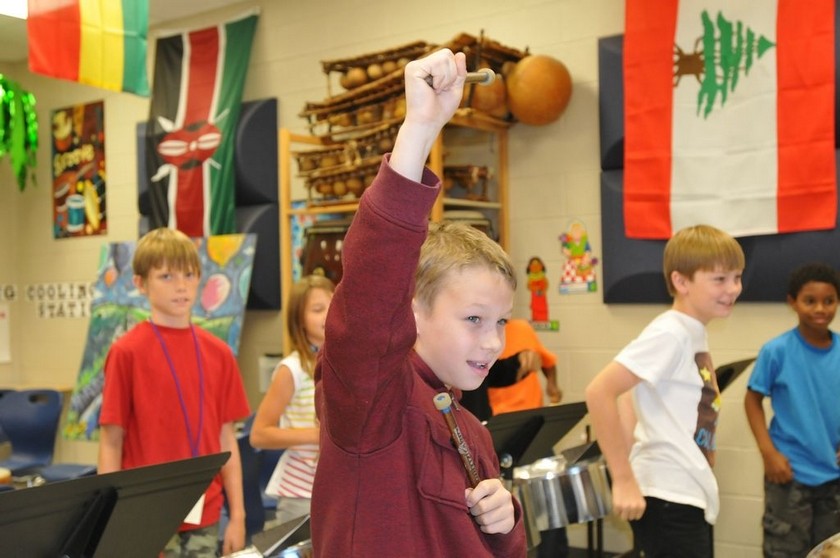“Creativity is as essential as literacy”

From the Summerville-Journal Scene:
Article & photos by Monica Kreber
Image: Talon Pinion does a little dance while playing the steel drums.
When a visitor walks into Kurry Seymour’s music class, students greet the visitor with a chorus of, “Welcome to our community.”
Seymour teaches multicultural music and arts at Joe Pye Elementary and, according to Seymour, it is the only school in the country that has a “world music” room with instruments that expose students to the cultures and practices of more than 15 different countries.
Seymour is taking his own approach to teach community, focus, purpose and life skills to DD2 students through multicultural music.
“The focus on community and how everyone matters is the guiding principle in my room,” Seymour said, adding that teachers from within DD2 and across the state come to observe the room and “community” regularly.
Seymour’s room is adorned with instruments from all over — such as steel drums from Trinidad and Tobago, and the taiko drums from Japan.
“All the instruments are authentic — they’re from all over the world,” Seymour said.
Seymour said at Joe Pye Elementary there are two music rooms; one that is more vocal and choral-based, while his is instrumental.The biggest thing, however, that he is trying to teach is community. The classroom is set up in such a way so students sit in a U-shaped assembly. They start with a “focus time,” where they look to each other and welcome their peers into the community.
In Seymour’s classroom it is important that students know everybody matters. “I use a lot of stuff that I do with them to teach them how to focus and have purpose,” he said. “There’s a really unique flow.”
Seymour said more people are taking to this approach because it is all fun for the students; it still covers state standards but students find it more exciting.
“They have to learn to read music, and they have to read and play because they find it exciting to play it on the drums,” he said. “The whole concept is if you don’t get a child excited young enough, like everything — science, math, music — then why would they go to middle school and do it?”
Seymour said he pushes them the same way he would with college students, but said it is not anything out of the students’ capability. They learn songs and hand signals from their teacher. All grades get to interact with the instruments, on various levels.
Seymour uses a tactic called whole brain teaching, which is based on call and response — an idea from Africa.
“It changed the way my classroom operates,” he said. “The teachers are starting to use more of it. Our whole school uses it. They’re using it in other schools because the hardest problem is keeping a kid engaged. The whole brain teaching thing keeps them engaged, with hand gestures and things to keep them moving.”
Seymour praises the Fine Arts Department at Joe Pye Elementary, saying all teachers try to connect their lessons in order to better help students. “I probably couldn’t really duplicate this job anywhere else,” he said. “I’ve never seen a district embrace the arts like this one.
“I believe creativity is as essential as literacy,” he said. “If a kid can’t read we have a problem with it, and if a kid can’t be free to be creative — and feel safe in an environment to do that — then I have a problem with that. I want them to be creative. Whether it’s in my room, or the dance room or the art room or the P.E. room, this is their opportunity to be free and have a good time.”

